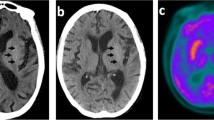Abstract
Hemichorea-hemiballism (HCHB) is an usually continuous, nonpatterned, involuntary movement disorder caused by basal ganglia dysfunction, commonly due to a vascular lesion, described in nonketotic hyperglycemic patients. Particular computed tomography and magnetic resonance imaging findings have been described. The pathogenic mechanism of chorea arising during hyperglycemia and the nature of neuroimaging findings are unclear. In this paper we describe two elderly women with onset of HCHB during a hyperglycemic episode. The symptoms persisted in one of them after recovery of normal glycemia. The pathophysiological mechanism of the disease is discussed in the light of clinical and neuroradiological follow-up.


Similar content being viewed by others
References
Bellassoued M, Mhiri C, Triki C, Abid M (2001) Hemichorea caused by striatal infarct in a young type 1 diabetic patient. Rev Neurol (Paris) 157:1287–1289
Chu K, Kang DW, Kin DE, Park SH, Roh JK (2002) Diffusion-weighted and gradient echo magnetic resonance findings of hemichorea hemiballismus associated with diabetic hyperglycemia. Arch Neurol 59:448–452
Dewey RB Jr, Jankovic J (1989) Hemiballism-hemichorea: clinical and pharmacologic findings in 21 patients. Arch Neurol 46:862–867
Ifergane G, Masalha R, Herischanu YO (2001) Transient hemichorea/hemiballismus associated with new onset hyperglycemia. Can J Neurol 28:365–368
Kashihara K, Nakashima S, Kohira I, Shohmori T, Fujiwara Y, Kuroda S (1998) Hyperintense basal ganglia on T1-weighted MR images in a patient with central nervous system lupus and chorea. AJNR Am J Neuroradiol 19:284–286
Ahlskog JE, Nishino H, Evidente VGH, Tulloch JW, Forbes GS, Caviness JN, Gwinn-Hardy KA (2001) Persistent chorea triggered by hyperglycaemic crisis in diabetics. Mov Disord 16:890–898
Higa M, Kaneko Y, Inokuchi T (2004) Two cases of hyperglycaemic chorea in diabetic patients. Diabet Med 21:196–198
Iwata A, Kolke F, Arasaki K, Tamaki M (1999) Blood brain barrier in hyperglycaemic chorea in a patient with poorly controlled diabetes. J Neurol Sci 163:90–93
Kim JS, Lee KS, Lee KH, Kim YI, Kim BS, Chung YA, Chung SK (2002) Evidence of thalamic disinhibition in patients with hemichorea: semiquantitative analysis using SPECT. J Neurol Neurosurg Psychiatry 72:329–333
Lai PH, Chen PC, Chang MH, Pan HB, Yang CF, Wu MT, Li JY, Chen C, Liang HI, Chen WI (2001) In vivo proton MR spectroscopy of chorea-ballismus in diabetes mellitus. Neuroradiology 43:525–531
Lin JJ, Chang MK (1994) Hemiballism-hemichorea and non-ketotic hyperglycaemia. J Neurol Neurosurg Psychiatry 57:748–750
Nath J, Jambhekar K, Rao C, Armitano E (2006) Radiological and pathological changes in hemiballism-hemichorea with striatal hyperintensity. J Magn Reson Imaging 23:564–568
Shan DE, Ho DM, Chang C, Pan HC, Teng MM (1998) Hemichorea-hemiballism: an explanation for MR signal changes. Am J Neuroradiol 19:863–870
Suto Y, Mori M, Kagimoto H, Saito J (2004) A case of hemichorea with hyperglycemia presenting with low signal intensity in the striatum on T2-weighted gradient-echo magnetic resonance imaging. Rinsho Shinkeigaku 44:86–90
Yahikozawa H, Hanyu N, Yamamoto K, Hashimoto T, Shimozono K, Nakagawa S, Yanagisawa N (1994) Hemiballism with striatal hyperintensity on T1-weighted MRI in diabetic patients: a unique syndrome. J Neurol Sci 124(2):208–214
Uchibori A, Kobayashi Y, Chiba A, Tsuchiya K, Sakuta M (2003) Abnormal MR findings in the temporal lobe and basal ganglia along with vasospasm in a case of hemiballism associated with diabetes mellitus. Rinsho Shinkeigaku 43:330–334
Romero Blanco M, Monteiro João G (2002) Hemichorea induced by diabetic ketoacidosis and striatal hyperdensity on computerized axial tomography. Rev Neurol 34:256–258
Hsu JL, Wang HC, Hsu WC (2004) Hyperglycemia-induced unilateral basal ganglion lesions with and without hemichorea. A PET study. J Neurol 251:1486–1490
Lee EJ, Choi JY, Lee SH, Song SY, Lee YS (2002) Hemichorea-hemiballism in primary diabetic patients: MR correlation. J Comput Tomogr 26:905–911
Rector WG, Herlong HF, Moses HD (1992) Nonketotic hyperglycemia appearing as choreoathetosis or ballism. Arch Intern Med 142:154–155
Lee BC, Hwang SH, Chang GY (1999) Hemiballismus-hemichorea in older diabetic women: a clinical syndrome with MRI correlation. Neurology 52:646–648
Wintermark M, Fischbein NJ, Mukherjee P, Yuh EL, Dillon WP (2004) Unilateral putaminal CT, MR and diffusion abnormalities secondary to nonketotic hyperglycemia in the setting of acute neurologic symptoms mimicking stroke. Am J Neuroradiol 25:975–976
Shimomura T, Nozaki Y, Tamura K (1995) Hemichorea-hemiballism associated with nonketotic hyperglycemia and presenting with unilateral hyperintensity of the putamen on MRI T1-weighted images—a case report. No To Shinkei 557–561
Nabatame H, Nakamura K, Matsuda M, Fujimoto N, Shio H (1994) Hemichorea in hyperglycemia associated with increased blood flow in the contralateral striatum and thalamus. Intern Med 33:472–475
Ohara S, Nakagawa S, Tabata K, Hashimoto T (2001) Hemiballism with hyperglycemia and striatal T1-MRI hyperintensity: an autopsy report. Mov Disord 16:521–525
Fujioka M, Taoka T, Matsuo K, Ogoshi K, Kondo Y, Tsuda M, Fujiwara M, Asano T, Sakaki T, Miyasaki A, Park K, Siesjo BK (2003) Magnetic resonance imaging shows delayed ischemic striatal neurodegeneration. Ann Neurol 54:732–747
Kimura A, Mitake S (2001) Repeated hyperglycaemic hemichorea in a patient with venous angioma in the putamen. Rinsho Shinkeigaku 41:113–116
Lim DK, Lee KM, Ho IK (1994) Changes in the central dopaminergic system in streptozotocin induced diabetic rats. Arch Pharm Res 17:398–404
Author information
Authors and Affiliations
Corresponding author
Rights and permissions
About this article
Cite this article
Battisti, C., Forte, F., Rubenni, E. et al. Two cases of hemichorea-hemiballism with nonketotic hyperglycemia: a new point of view. Neurol Sci 30, 179–183 (2009). https://doi.org/10.1007/s10072-009-0039-5
Received:
Accepted:
Published:
Issue Date:
DOI: https://doi.org/10.1007/s10072-009-0039-5




